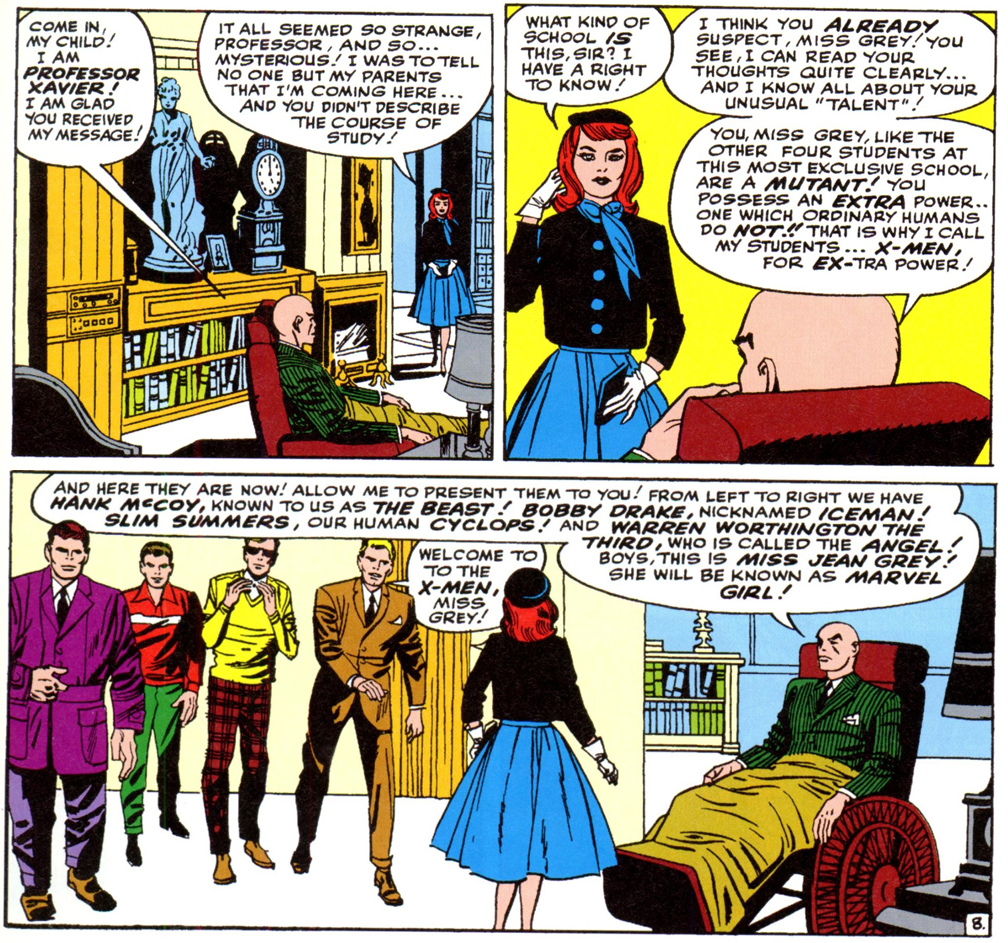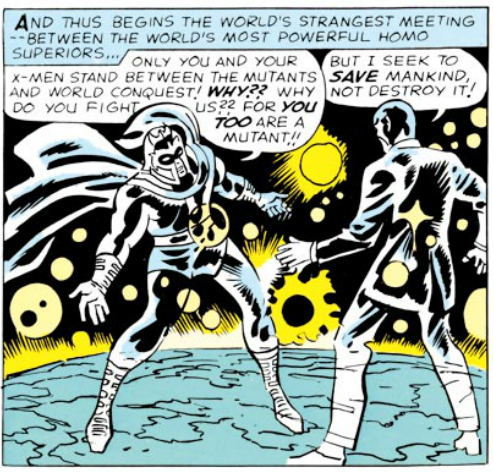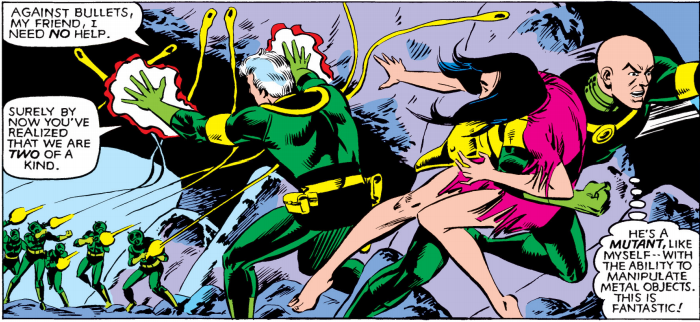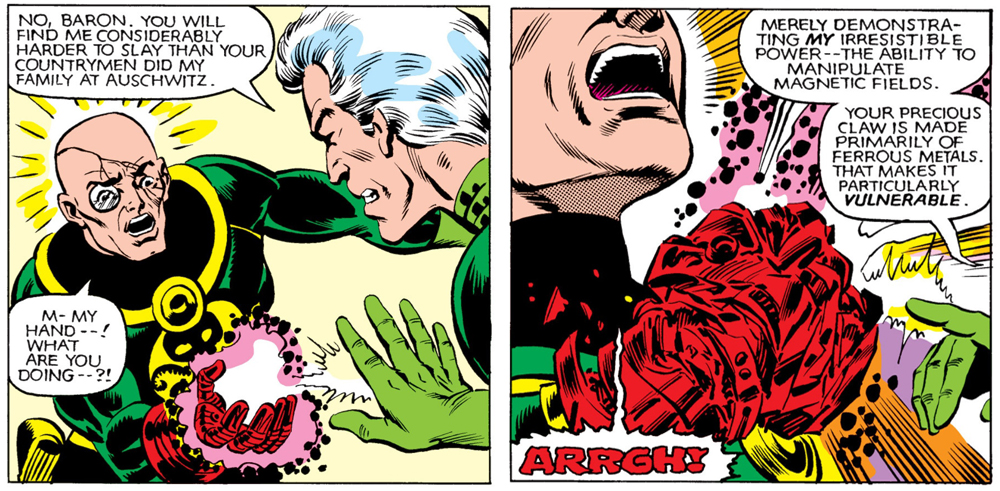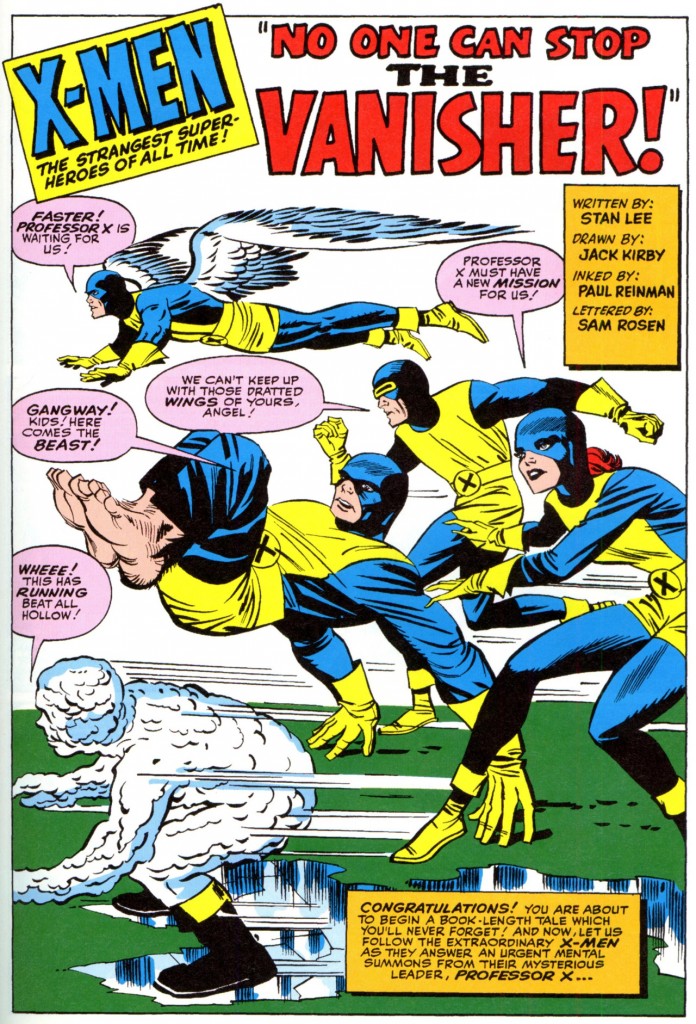With the release of the first X-Men film in 2000, audiences not only witnessed the dawn of the modern day superhero film boom, but also the beginning of a complicated franchise that would span sixteen years and nine films. With X-Men: Apocalypse on the horizon, Kayleigh Hearn and a rotating cast of merry mutants are revisiting the X-Men films from the very beginning, and examining the comic book storylines that inspired them. What would you prefer, yellow spandex?
Uncanny X-Men #1-4, #161
By Stan Lee and Jack Kirby, Chris Claremont and Dave Cockrum
Kayleigh: For this week’s X-Education, we’re skipping through X-Men history a bit. X-Men: First Class takes its name from a series that ran from 2006-2009 and told modernized tales of the original five X-Men: Cyclops, Beast, Iceman, Angel, and Marvel Girl. The series is cute but inconsequential, and it would be more relevant to go back to the very beginning: X-Men #1-4 by Stan Lee and Jack Kirby. How does the 1960s-set X-Men: First Class compare to the actual ’60s comics that introduced Professor X, Magneto, the X-Men, and the Brotherhood of (Evil) Mutants? Then I wanted to jump ahead to Claremont and Cockrum’s Uncanny X-Men #161, which reveals Professor X and Magneto’s real first meeting.
Dominic: I grew up reading reprints of the prime era Claremont/Byrne stuff, and I’m a little ashamed to admit this is my first time really reading any of the Lee/Kirby X-Men. Lee’s authorial style really inspires the absurdity of Xavier’s telepathic voiceover narration, dominating this book about horned up, superpowered teenagers with the legitimately disturbing inner thoughts of a creepy patriarch who, the book shows, can essentially do whatever the hell he wants? The second issue has him giving a dude the equivalent of a lobotomy. If this was Identity Crisis we would have had to explore that for six more issues! It’s so distant to the more iconic work Claremont would eventually do on the book, but as a foundational starting point, it still holds up.
Kayleigh: Lee/Kirby X-Men comics are such weird little time capsules! Immediately we’re introduced to so many iconic elements–the blue and yellow costumes, the Danger Room, Magneto and his magnificent helmet. X-Men creators are still pulling from this era–with All-New X-Men literally pulling these baby X-Men into the present. Even Iceman’s recent coming out can be traced back to his “A girl…big deal!” reaction to Jean Grey’s enrollment in the very first issue. And yet it feels oddly…half-formed? You can kind of tell that this is from the period where, like, X-Men #3 or whatever was the 53rd comic Lee and Kirby were working on that month, and this was not a book where they were putting their biggest and best ideas.
Dominic: Yeah, the core axis of mutantkind vs humanity and the ideological beef between Xavier and Magneto is like barely evident here. These first four issues are fun, for sure, and it’s the beginning of something special, but it’s not like early Fantastic Four where you’re like holy fuck this is insane. Also, again, I have to reiterate how fucking sketchy Xavier is. Did Stan Lee feel like seeding a subplot about the Professor being in love with his teenage student was really necessary amid the rest of the world building? Was he just exorcising some personal demons about an intern he had a work crush on? What is the deal here? Aside from that odd bit of Lolita existentialism, I love that the team feels diverse, despite being four white dudes and a white girl. They’re very quickly established as being individuals, which is impressive, given how little page space is devoted to characterization over exposition.
Kayleigh: The mutant metaphor, or at least the idea of the X-Men as persecuted misfits, is totally absent. They’re practically celebrities, like that hilarious scene in issue #2 where teenage girls swarm Angel like he’s one of the Beatles, and Jean petulantly sends them flying. Lee’s 1960s writing can be criticized for being big and broad (and full of ridiculous “hip” slang), but he had an uncanny knack for tapping into classic, relatable archetypes. For all the sexism permeating these issues, Jean Grey still gets a pretty great introduction, refusing to let the boys pull up a chair for her and sending Beast flying across the room when he gets fresh. Jean’s like those 1960s Barbies with the amazing resting bitch face, I love it.
Dominic: I was really impressed with how exciting some of the depictions of mutant abilities were realized by Kirby. Xavier displaying mental images onto a bare wall like a projector presentation, for instance, felt really innovative. It’s very comic book-y in the primordial sense, but you can tell that relentless spirit of invention is at play, even if in a more muted way than other early Marvel titles. It’s also fascinating to see the X-Men in the real 1960s after rewatching them in a facsimile of the time period, where the only real signifier was people saying “groovy” a lot.
Kayleigh: Even when Jack Kirby maybe wasn’t giving 100%, his work is vibrant and imaginative and just really, really, fun to look at. I particularly love Xavier and Magneto meeting in the astral plane in #4: it’s only two panels, but it feels cosmic and epic, like these are already larger than life figures.
Dominic: I have to say that particular exchange is definitely my favorite in these early adventures. I’m a real mark for Xavier/Lehnsherr slash, so my ideal X-Men comic is just them erotically glowering at one another over a chess board. One thing that struck me was how dense the storytelling here is compared to what we’re used to in modern comics, but it STILL isn’t as dense as the Claremont stuff that would follow.
Kayleigh: That’s a great transition to Uncanny X-Men #161, “Gold Rush,” by Chris Claremont and Dave Cockrum. This is an incredibly important X-Men comic considering the history it establishes, but I rarely see it talked about. After an encounter with the Brood, Professor X is in a catatonic state, reliving memories of a fateful trip to Israel where he befriends a man named Magnus who will one day become Magneto. Xavier and Magneto as old friends turned enemies would become a huge component of the X-Men mythos, and the retcon is one of the most brilliant moments of Claremont’s run. Lee and Kirby’s Magneto was a villain with a capital V, with no characterization beyond his desire for mutant world domination. (In the Lee/Kirby run he never even takes his helmet off, driving home the idea that he was a supervillain rather than a person.) It took over 150 issues for Magneto to be given any kind of history or nuance, and in a single issue Claremont gives Magneto an incredible motivation: he’s an Auschwitz survivor who wants to save mutantkind from the kind of bigotry that destroyed his family.
Dominic: It really makes him a true Marvel character for the first time, I feel. Also the fact that they don’t shy away from real Nazis. None of that “oh it’s just Hydra” bullshit from The First Avenger. This also fleshes out Xavier a little bit, expanding upon the sort of tortured inner life Lee teases back in UXM 1-4, as he struggles with this strange romance with a Holocaust survivor. The fact that this standalone tale is sandwiched between so many other plot strands is impressive. Claremont juggles so many bouncing balls here, and Cockrum’s art has an expressive beauty I’d forgotten I loved.
Kayleigh: The explicit Nazism of Hydra is even more disturbing considering how in 2016 Baron Von Strucker and his ilk have been sanitized to be made into toys and t-shirts. But just as Fassbender hunting down Nazis in First Class was immensely entertaining, it’s very satisfying to read a comic where Magneto effortlessly thrashes Hydra trash. (“Oh, the Satan Claw? That’s cute. *CRUSH*”) Dave Cockrum’s artwork is really fantastic here, from the cover that looks like it came straight from the best 1980s pulp novel you ever read, to these really cerebral, intense scenes inside Xavier and Gabrielle’s minds. Gabrielle visualizing a Nazi torturer as a green-skinned monster with a machine gun is just a striking image. I love Claremont’s ultra-compressed, soap opera writing style. One of the biggest surprise reveals in X-Men history–Xavier and Magneto are lifelong friends!–is just an interlude in a long-running space drama about alien royalty and Xenomorph rip-offs.
Dominic: That’s the thing that’s mind-blowing to me. We start here with Lee & Kirby, the originators of this universe, and it’s a fun, if quaint, excursion, but Claremont has written more X-Men comics than anyone. There are so many things we consider to be systemic to the mythology that have almost nothing to do with the original premise and the underlying metaphor about otherness. Space, time travel, sprawling family ties. All of these things are Claremont touches that are ingrained in the X-franchise forever now. His work is where so much of the enduring identity of the X-Men is born.
Kayleigh: next week: The Facts of Life The Wolverine goes to Japan!


